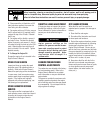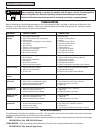
Maintenance
5
Section
17
Before inspecting, cleaning or
servicing the machine, shut off engine,
wait for all moving parts to come to a
complete stop, disconnect spark plug
wire and move wire away from spark
plug. Remove ignition key on electric
start models.
Failure to follow these instructions can
result in serious personal injury or prop-
erty damage.
WARNING
MAINTENANCE SCHEDULE
PROCEDURE NOTES
Check motor oil level 2, 3
Clean engine 2, 7
Check drive belt tension 1, 4
Check nuts and bolts 1, 4
Change motor oil 4, 6, 9
Lubricate tiller 4
Service engine air cleaner system 7
Check gear oil level in transmission 1, 5
Check tines for wear 5
Check air pressure in tires (if unit
has pneumatic tires) 5
Service spark plug 7
NOTES
1 - Check after first 2 hours of break-in operation.
2 - Before each use.
3 - Every 5 operating hours.
4 - Every 10 operating hours.
5 - Every 30 operating hours.
6 - Change more frequently in dusty or dirty
conditions.
7 - See Engine Owner’s Manual for service
recommendations.
8 - Whichever time interval occurs first.
9 - Change after first 2 hours of break-in
operation.
TILLER LUBRICATION
After every 10 operating hours, oil or
grease the lubrication points shown in
Figure 5-1 and described below.
Use clean lubricating oil (#30 weight
motor oil is suitable) and clean general
purpose grease (grease containing a metal
lubricant is preferred, if available).
• Remove the wheels, clean the wheel
shaft (A, Fig. 5-1) and apply a thin
coating of grease to the wheel shaft.
• Grease the back, front and sides of the
depth regulator lever (B, Fig. 5-1).
• Remove the tines and clean the tine shaft
(C, Fig. 5-1). Use a file or sandpaper to
gently remove any rust, burrs or rough
spots (especially around holes in shaft).
Apply grease to ends of shaft before
installing tines.
• Oil the threads on the handlebar height
adjustment screws and the handlebar
attaching screws (D, Fig. 5-1).
Figure 5-1
A
B
C
D
If a cover is leaking, check for loose
screws. If the screws are tight, a new
gasket or oil seal may be required.
If the leak is from around a shaft and oil
seal, the oil seal probably needs to be
replaced. See your authorized dealer or
contact the factory for service or advice.
IMPORTANT: Never operate the tiller if the
transmission is low on oil. Check the oil
level after every 30 hours of operation and
whenever there is any oil leakage.
CHECK HARDWARE
Check for loose or missing hardware after
every 10 operating hours and tighten or
replace (as needed) before reusing tiller
Be sure to check the screws underneath
the tiller hood that secure the transmission
cover and the Depth Regulator Lever to the
transmission.
CHECK TIRE PRESSURE
(Models with pneumatic tires)
Check the air pressure in both tires. The
air pressure should be between 15-20 PSI
(pounds per square inch).
Keep both tires equally inflated to help
prevent machine from pulling to one side.
TRANSMISSION GEAR
OIL SERVICE
Check the transmission gear oil level after
every 30 hours of operation or whenever
you notice any oil leak. Operating the tiller
when the transmission is low on oil can
result in severe damage.
A. To Check the Transmission
Gear Oil Level:
1.
Check the gear oil level when the trans-
mission is cool. Gear oil will expand in
warm operating temperatures and this
expansion will provide an incorrect oil
level reading.
2. With the tiller on level ground, pull the
Depth Regulator Lever all the way up.
3. Remove the oil fill plug (A, Fig. 5-2)
from the transmission housing and look
inside the oil fill hole to locate the main
drive shaft situated below the hole.
CHECK FOR OIL LEAKS
Before each use, check the tiller for signs
of an oil leak – usually a dirty, oily accu-
mulation either on the unit or on the floor.
A little seepage around a cover or an oil
seal is usually not a cause for alarm. How-
ever, if the oil drips overnight, then imme-
diate attention is needed.
Ignoring an oil
leak can result in severe transmission
damage!


















